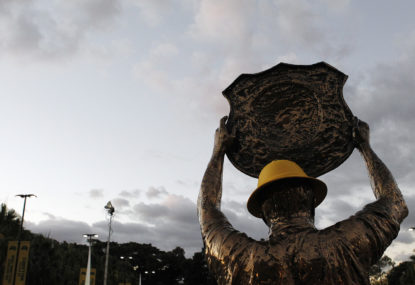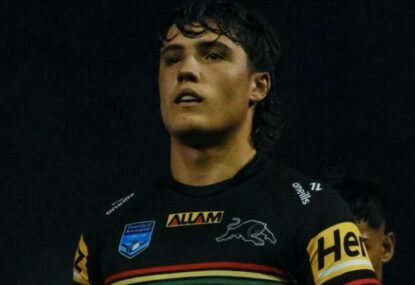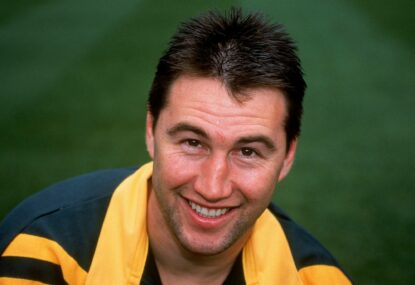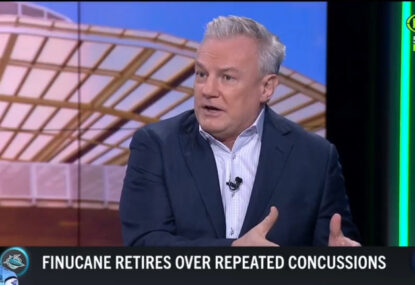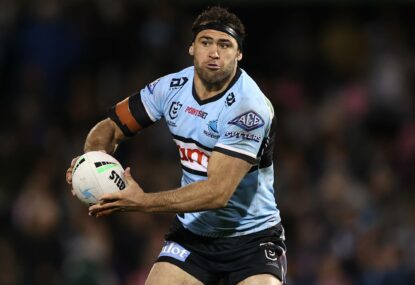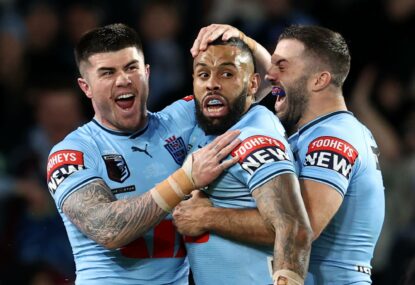As we inch ever closer to the 2017 Rugby League World Cup, it may be mindful to reflect on the past. Can this current squad match the feats of previous Australian teams? Can they place their names down as a unit and declare to be one of the best Australian teams ever?
The 1982 Kangaroos had set the benchmark. Obviously, the 1986 touring party had a reputation to live up to. The fact that they did so and in such a wonderful manner is a testament to all who were involved in the 16th Kangaroo tour.
So, for now, enjoy the story of the 1986 Kangaroos.
To begin with, there was controversy – once again – over the selection of the touring side. Wayne Pearce had injured his knee in the third Test against New Zealand earlier in the season. His dedication to his fitness allowed him to stay in shape and by the time the touring side was being announced, he felt fit enough to play. However, the doctor at the time disagreed, and he was left out of the squad.
Ben Elias, Steve Roach and Paul Sironen were the Balmain connection for the tour. Wally Lewis was named the captain of the team. A remarkable achievement as he became the first Queenslander to do so since the 1920s.
Under the tutelage of Don Furner, the Australian team started their tour with a Test against Papua New Guinea. If you are ever lucky enough to travel to our northern neighbour, you will enjoy the hospitality and warmth of the people.
Fortunately for the Australian team, they were never a chance of losing as they ran out comfortable winners 62–12, unfortunately, the Australians received brutal hits that made their bones rattle.
The locals threw everything into the contest which pleased the 17,000-strong crowd who worshipped the Australian players like they were living gods.
From here the tourists travelled to Manchester where they were to compete against the mighty Wigan side. This Wigan side was at the beginning of its run as the most powerful English rugby club, and hopes were high that they could cause an upset.
A 30,000-strong crowd watched their heroes battle it out against the Kangaroos and although struggling to find traction going into the half 16–2 down, the locals persevered.
Coming out in the second half like men possessed, the cherry and whites threw everything they had at the Australians. Like the champion team they were, the Kangaroos managed to stave off the comeback to win 26–18.
In the Wigan team that day, a young Ian Roberts showed his true talents while in the halves Shaun Edwards and Mike Ford directed them around the field excellently while providing options to the outside backs where Dean Bell and Henderson Gill could threaten. After the game, fans rushed onto the field to embrace the players and enjoy the atmosphere.
The first game gave the English fans hope, but the second game against Hull Kingston Rovers reminded them what they could expect during the tour, an Australian onslaught. Terry Lamb scored five tries as Australia destroyed their opponents. Being ten points down at halftime was the best Roger Millward’s chargers could achieve.
By fulltime, the Kangaroos triumphed 46–10.
The city of Leeds was to host the Kangaroos at Headingley. Leeds were not the superpower of English rugby that they are now. In fact, for a city that loves its rugby league, they had continuously underperformed. Their luck did not change on Sunday the 19th of October as Leeds could not score a single point.
Australia won 40–0.
For the Kangaroos, Wally Lewis was a champion with no equal, he and Michael O’Connor scored two tries apiece while Noel Cleal, Greg Dowling, Gary Jack and Brett Kenny also crossed the line. It would not be until the Super League era that Leeds Rugby League Football Club achieved their potential.
Cumbria is one place you should visit if you ever happen to travel to England, the people are friendly, the landscape is nice and they play rugby league with a passion. Unfortunately, this passion for the game did not translate into victory against the tourists. They did manage to score two tries but were outclassed by a far superior Australian team.
Australia won 40–12.
This match gave Don Furner a selection headache for the first Test at Old Trafford as every player had performed so well. A record crowd of 50,000 fans jammed into Old Trafford. The majestic ground inspired a solid first half from the Australian team and with Michael O’Connor on fire Australia led 16 to nil.
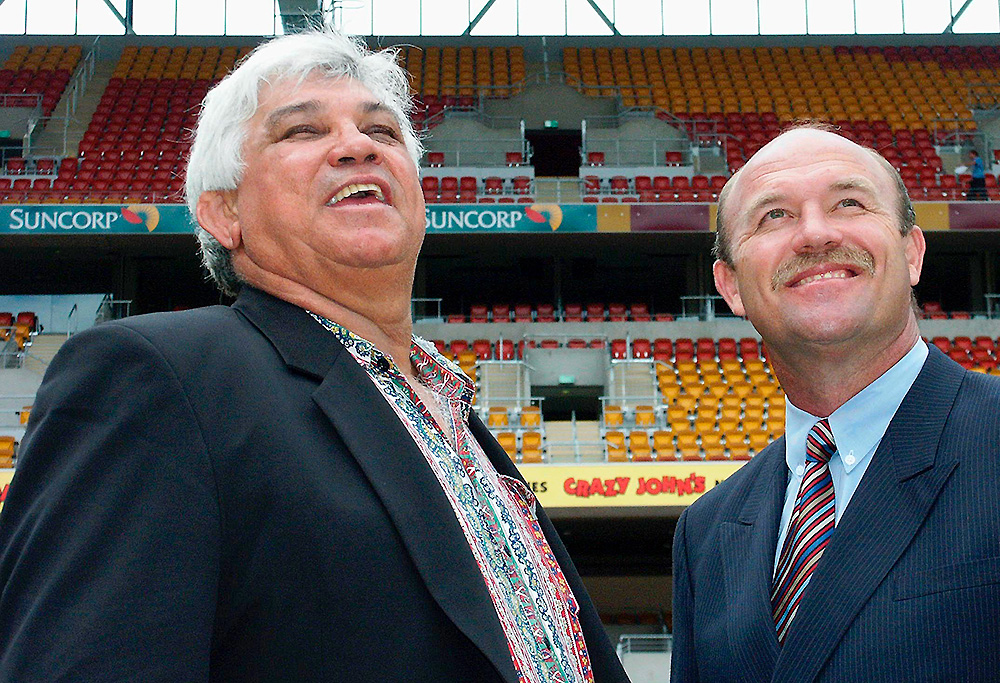
(AAP Image/Gillian Ballard)
Although the English included a very good backline consisting of Joe Lydon, Ellery Hanley, Gary Schofield, Henderson Gill and a classy second rower in Lee Crooks, they were not to challenge the conquering Australians. They needed more than individual brilliance, and once again, they did not have a team full of international standard players whereas the whole Australian touring party was of Test standard.
Australia won 38–16.
Although Halifax included Graeme Eadie and Chris Anderson, they still did not put up a resistance against the Kangaroos. Greg Alexander was silky smooth, Terry Lamb was a bulldog through and through and Brett Kenny was all class even when put on the wing.
The issue of fitness was becoming a re-occurring theme as Halifax had managed to contain the Australians in the first half to 14–2, yet by fulltime Halifax remained on two while the Australians finished with 36.
The Australian team then travelled back to Knowsley Road, St Helens to play in front of 15,000 mad, crazed fans. By fulltime, a sea of sorrows confronted the victorious Australians as they won 32–8. The try scorers for Australia were: Dale Shearer (2) with Noel Cleal, Mal Meninga, Gene Miles and Bryan Niebling scoring one each. Meninga kicked three goals while Lamb converted one. For St Helens, no tries were scored; Paul Loughlin converted four kicks.
In Oldham on a November night, the air is as cold as ice. This cold may have affected the Australians as they battled it out with men who were all steamed up and ready to rumble. The Oldham players were lions on the battlefield. This battle spilt into open hostilities as Martin Bella, Steve Folks, Paul Sherman and Mick Worrall were sin-binned through the course of the contest.
During the game, the Oldham team displayed guile in creating breaks to a defensive line that had not seriously been threatened. The Oldham players passed with flair, ran with an iron will and kicked with purpose. Though as the wind howled in protest, the Australians clung to a one try victory 22–16.
As the Oldham players departed the Watersheddings field, they were rightfully greeted by a standing ovation. The Oldham club was close to being the first English team to beat Australia since 1978.
The ninth game in England, saw the Australians travel to Leeds for the second Test to try and reclaim the Ashes at Elland Road in front of a crowd of 30,000. Wally Lewis was not called the King for no reason, he was unstoppable in motion as he strolled across the line for a try. His defence was like a brick wall, and his skill with the ball was a magic show for an unbelieving audience.
Other Australians also showed their class, Peter Sterling revealed to all why he was the best halfback of the 80s, Brett Kenny confirmed his quality – he was so good that he could move to the centre position and shift Meninga, a giant of the team, to the bench.
Once again, the English had to rely on individual brilliance. Gary Schofield out in the centres was always challenging, scoring a solid try. Lee Crooks was consistent, the British halves of Tony Myler and Deryck Fox tried their best, but against Sterling and Lewis, they were no chance.
Gary Jack got the nod over Gary Belcher for the fullback position and came away with two tries. Michael O’Connor was sensational again with a try and five goals. When the final siren sounded, the home crowd felt like life had passed them by. They wondered when their national team would win against an Australian team that just seemed to get better.
Australia had retained the Ashes by beating England 34–4.
The industrial town of Widnes was fortunate enough to host the Kangaroos, they were unsuccessful in 1982, though this time they put in a far better effort. Widnes was unable to cross the white line, having to rely on two penalty kicks to get on the scoreboard. Martin Bella, Chris Mortimer and Gary Belcher were the try scorers while Lamb and Meninga plotted two goals.
[latest_videos_strip category=”league” name=”League”]
A crowd of over 10,000 showed the passion of the town in supporting their rugby league side despite the financial difficulties that were plaguing many in England at the time. The year of 1986 was a preview of the greatness that the Widnes team would achieve in the years to follow.
In the 1982/83 season, Hull FC was the best British rugby team. In the 1982 tour, they had led the Australians 7-0 at halftime before going down in a fierce contest 13–7. On this tour, things had changed and for the worse. They were thumped! They did not score a single point in their 48 to nil loss.
The Kangaroos attack was unstoppable. Terry Lamb’s support play was sensational as he picked up two tries. Des Hasler also crossed twice, while Meninga, Miles, Sterling, Shearer and Gary Jack crossed over for scores. The 80s super boot of O’Connor plotted six goals. Sterling’s try from a scrum win was the highlight of the match.
In the last tour game before the third and final Test, the Australian team travelled to Bradford. Bradford lies west of Leeds and although it has the presence of an industrial town, it is surrounded by many open spaces that are conducive to producing good rugby players.
The spectacle was spoiled as the fog rolled over the ground like a blanket making it extremely difficult for the television audiences and the fans at the game struggled to see what was unfolding.
Ultimately, for the 10,000 fans present that day, they were to witness their local heroes fail to score a single point. As the fans filed out of the ground, they were once again confronted by the depressive reality that it would be a long time before they were to have their place in the sun.
In the years to come, the Bradford Bulls as they became known became the dominant team of Super League’s early years. Now though, they sit in National League One – the third tier of English rugby league.
The third and final Test, Wigan. The Kangaroos were an avalanche that devoured everything in its path. This avalanche could explain why the Wigan faithful had not turned up in the numbers that they had done for the first tour game.
Still, 20,000 fans were to witness the closest that the national team had come to achieving victory. Andy Gregory returned at halfback and was instrumental in shaping the British fortunes. Gary Schofield support play was exceptional, and his cunning play resulted in him scoring two tries.
The game was a thrilling contest of old enemies trying to gain final bragging rights. The British hoped to end the drought and gain some semblance of respect while the touring team wanted immortality, to be remembered just as the 1982 team was remembered. The 1986 Kangaroos aimed to be the best.
The Lions forward pack seemed more interested in taking a swing at the Australian heads than making an effective tackle. This mode of tackling allowed a brilliant offload to fall into Gene Miles hands and saw him race away for the first try.
Around the two-minute mark, the Australians were presented with the opportunity to attack the British line. This moment was a chance for the British to show their resolve – they failed. A backline movement which did see the ball hit the deck before being passed on presented Bob Linder with a big gap and an easy run for Australia’s second try.
Great Britain would usually drop their heads at this point, but not today. Around the 30th minute, a good offload by Harry Pinner saw Tony Myler race downfield, and a short offload to Schofield saw the hosts close the gap. A late attack by the British came close, but they were unable to connect the final pass. The game was in the balance at halftime with Australia leading 12–6.
[latest_videos_strip]
The second half began ferociously as a sublime backline move resulted in Gary Schofield crossing for his second try, and with the successful conversion, the game was tied 12-all. It was a close contest, but then fortune fell Australia’s way. Dale Shearer made a break down the sideline and kicked ahead; the French referee awarded a penalty try when Shearer was tackled without the ball. Australia now led 18–12.
What followed next reveals the cultural difference between the two teams, the all-out attack of the Australians and the conservative British.
Firstly, the British were awarded a holding down penalty right in front of the posts, so instead of going for the equalising try, they took the two points. Secondly, Gary Schofield completed a field goal to bring the game to 18–15 when a bomb to the in-goal to attempt to get a repeat set would have been a wiser option.
Regardless, the British were storming home and the faithful were confident of seeing their team win.
Similar to four years prior, it took until the third Test before the Lions showed their teeth and fiery will. Despite this resolve, a blindside move by Wally Lewis opened up the defence and he ran through, moving his way closer to the posts to put the tourists further ahead. The British were left chasing their tail as they crashed to a 24–15 loss.
The British were left wondering why they could not have performed like that in the previous two games while the Australians took satisfaction in a job well done. Paul Dunn won the man of the match, but any number of players starred in this game.
Terry Lamb, named on the bench, had now played in every game on tour to date. A mammoth task that probably would be forbidden from occurring now if they were ever to return to a traditional style tour. It would not be until the third Test in Sydney in 1988 that the Lions would achieve their breakthrough win against Australia.
The Kangaroos departed a downcast England for France. As in the early 80s, the game of rugby league in France was in severe decline. It was now almost a health hazard having the Australian team compete against the French. A few towns in the south kept the candle burning for the game, but the game was ultimately on life support.
Prejudice from rugby union officials and under the table payments kept the quality players in France playing rugby union. So, all that was left to confront the 1986 Kangaroos were Frenchmen who were unable to attract the money union was secretly paying or those who played for love and passion of the game.
The skill difference in the two countries was wider than the Grand Canyon.
Less than 1000 fans attended the first game in which Australia beat the French President’s XIII 36–4. In Perpignan, for the first Test against the French national team, 6000 fans from a once mighty nation of rugby league witnessed what could have been a death blow for the game. Australia won 44–2 with Michael O’Connor scoring three tries to continue his magnificent form on tour.
As the tour reached December, the Kangaroos continued their winning ways beating Le Pontet XIII 42–5. Some strange refereeing decisions kept the following game close, but could not stop the inevitable as Australia ran out to a 12–2 victory over Midi-Pyrenees XIII.
Another big win came in Albi against a secondary French team. The 50-0 walloping added insult into the wounds of French rugby league. Fortunately for the game, the French knew that from this moment they had to change their systems and structure or the sport would die.
Although Aquitaine was also defeated heavily 50–8, the French mindset had changed. Naturally, it would not affect the final match of the 20-game tour, but in years to come the game would slowly grow once more.
Granted, with the growth of rugby union, rugby league’s transition into a stable sport has taken longer than the French had hoped. While the game in France may never equal the success of its union counterpart, it has made some strides. The Catalan Dragons are in the Super League, Toulouse is in the Championship and French players are scattered across a range of English clubs while the French league still competes in its traditional homelands.
Obviously, none of this was to help them when they were confronted with the awesomeness that was the 1986 Kangaroos in the second Test in Carcassonne. Australia ran with ease and despite the niggling tactics of the hosts, cruised to a 52-0 win. They had equalled the record of the 1982 Kangaroos. They had gone undefeated and were simply unbeatable.
Upon returning to Australia, the Australian public’s interest in international footy had now been replaced by the State of Origin series. The people wanted a contest, the people wanted to the see the best, and that was now New South Wales versus Queensland.
A Kangaroo tour of Britain and France was to take place in 1990 and 1994, and the British came terribly close to obtaining the Ashes, winning the first game of each series. Then Super League changed the rugby league landscape forever. It burnt bridges and threw tradition out the window. The Australian jersey was devalued when not all the best players were selected.
The English game switched to summer and as a consequence, the traditional tours no longer take place. Although they are being re-introduced, they will not be of the full length that they once were. Therefore, this has allowed the 1986 Kangaroos to remain a standard bearer for all future Australian Kangaroos Test teams.
Can 2017 Kangaroos showcase the flair, the skill, the absurdity of attack, the ruthlessness of defence that the 1986 Kangaroos displayed? If they do, it will be one brilliant World Cup.
For the record the 1986 Kangaroos achieved the following:
– 20 games
– Scored 136 tries
– Conceded 16 tries
– Posted 738 points for 36.9 average per game
– Allowed 126 points against for an average of 6.3 per game.
The 1986 Kangaroos
Coach: Don Furner
Captain: Wally Lewis
Greg Alexander
Gary Belcher
Martin Bella
Noel Cleal
Phil Daley
Les Davidson
Greg Dowling
Paul Dunn
Ben Elias
Steve Folkes
Des Halser
Gary Jack
Brett Kenny
Les Kiss
Terry Lamb
Paul Langmack
Bob Linder
Mal Meninga
Gene Miles
Chris Mortimer
Bryan Nielbling
Michael O’Connor
Steve Roach
Dale Shearer
Royce Simmons
Paul Sironen
Peter Sterling






























































































